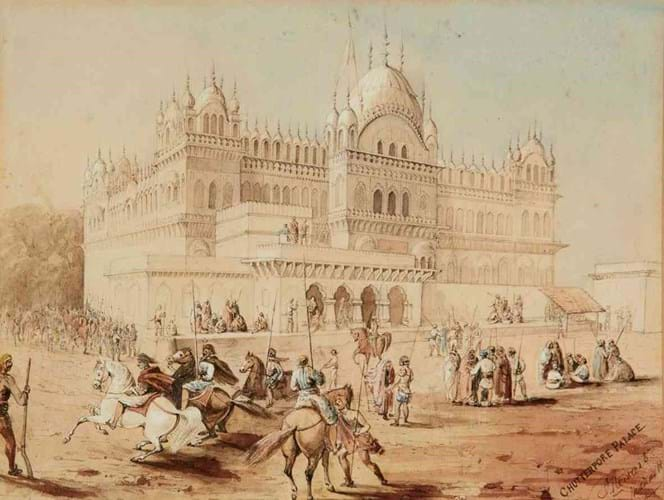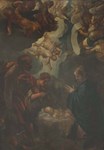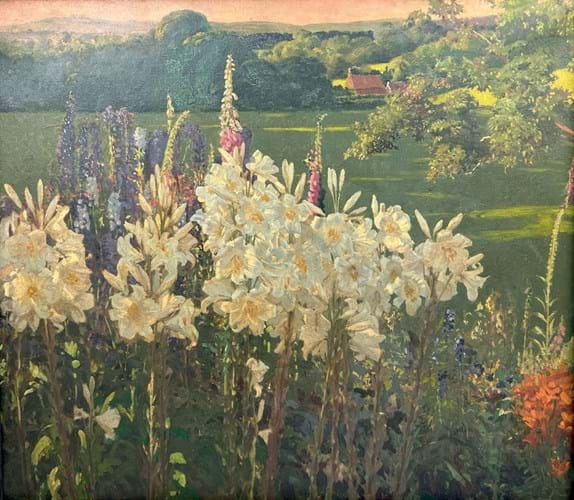
The gamble of spotting and then entering into a fervent bidding competition on what might be an unidentified or under-catalogued work at auction is what makes the blood flow for many dealers.
But more and more it is private sleeper spotters too who are engaging in this pursuit.
A recent example came at Wimbledon Auctions (22% buyer’s premium) in south London when a large painting of flowers in a landscape with a small house in the background drew the attention of a number of parties, all seemingly private buyers on the look-out for a bargain or a ‘research project’.
Offered unattributed and estimated at £400-600 at the sale on April 24, the 2ft 6in x 2ft 1in (76 x 64cm) oil on canvas was part of a deceased estate.
It had apparently been kept in a local house for a long time and was found in a rather cluttered room by the house clearance company Just Clear that removed it on behalf of the family and provided it to the Wimbledon saleroom, a relatively new firm which was founded in 2022.
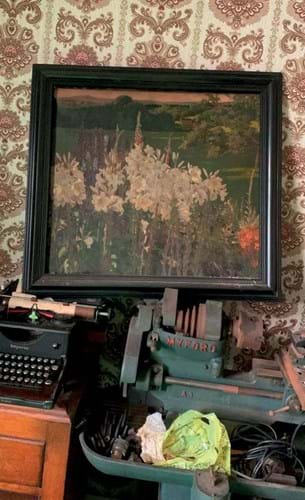
The landscape with flowers, thought to be the work of Charles Daniel Ward, as it was found in a cluttered room by a house clearance company before selling for £7500 at Wimbledon Auctions.
While it is not known how the original owner acquired it, the auction house believed the picture had a certain painterly quality and the catalogue noted that it was indistinctly signed Ward.
The work was not dated but was thought to have been painted in the late 1920s. Its condition was good for its age with no obvious defects, although it was mounted loosely within its frame.
At least three bidders seemed convinced that it was the work of Charles Daniel Ward (1872-1935), a well-known artist in his day who exhibited at the Royal Academy in London from 1898-1932 as well as at the Royal Institute of Oil Painters.
The Somerset-born painter was a skilled and versatile draughtsman who produced portraits, genre scenes, landscapes and flower studies. Many of the latter were made in Blewbury, Oxfordshire, where he moved to with his wife, the artist Charlotte Blakeney Ward (1873-1962). He often painted alongside her en plein air.
Ward’s most famous work is Progress of Spring, a large allegorical scene from 1905 which sold at Christie’s for £31,000 in 1993 and is now in The Dahesh Museum of Art in New York, a gallery dedicated to works by European academically trained artists (Ward himself studied art at the Royal College of Art where he met his future wife).
As well as the link to Ward, the fact that the work was a bright and colourful landscape with attractive details, especially to the flowers themselves, meant it resonated with bidders in any case.
On the day, three parties on the internet competed for the lot, taking it up to at £7500, at which point it was sold via thesaleroom.com.
Only four works by Ward have exceeded this sum at auction according to Artprice, including The Obsequious Persian, a elegant painting of a young woman and her cat from 1911, that twice sold at Sotheby’s for a record £40,000 (first in 2001 and then 2004).
After Rattray

One of three lithographs of Afghan subjects, part of a portfolio of prints after original drawings by James Rattray that made £8600 at Cato Crane.
Another lot generating fierce competition against what proved to be a lowly estimate this spring was a portfolio of lithographs with Afghan subjects.
Offered at Liverpool saleroom Cato Crane (28% buyer’s premium) on March 16, the prints were all based on the original drawings of James Rattray (1818- 1854), a soldier and artist from Northamptonshire who fought in the First Anglo-Afghan War from 1839 to 1842.
Rattray was a lieutenant in the 2nd Grenadiers, Bengal Army, serving alongside his elder brother Charles who was killed in November 1841 while on duty at Lughmani, in the Kabul valley.
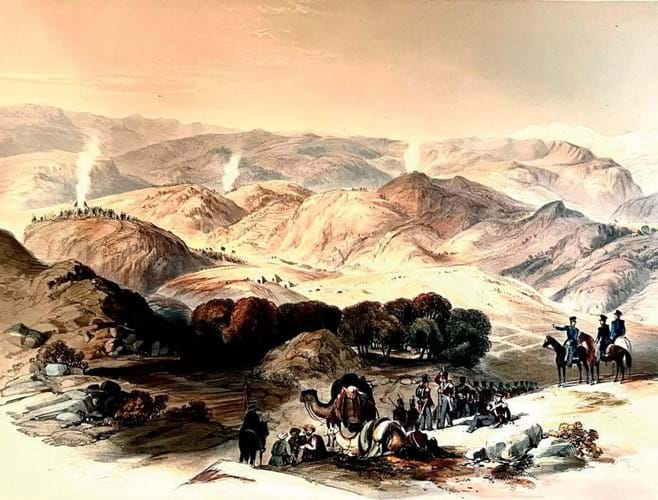
One of three lithographs of Afghan subjects, part of a portfolio of prints after original drawings by James Rattray that made £8600 at Cato Crane.
The meticulous and lively studies depict the people and topography, as well as the country’s cities, landmarks and military subjects.
Rattray’s sketches were later published by Day & Son in 1847 as a bound volume, with four lithographers producing the prints which were published as a collection along with a commentary by the artist with the title ‘The Costumes of the Various Tribes, Portraits of Ladies of Rank, Cerebrated Princes and Chiefs, Views of the Principal Fortresses and Cities, and Interior of the Cities and Temples, Afghaunistaun’.
The portfolio here was a second edition volume from 1848 published by Hering & Remington in London. The edition featured 29 hand-coloured lithographs, many heightened with gum Arabic.
It was consigned by a private Wirral vendor along with a group of collectables. According to the auction house, it had been in the vendor’s family for a long time and was probably acquired by a relative who had been a book collector.
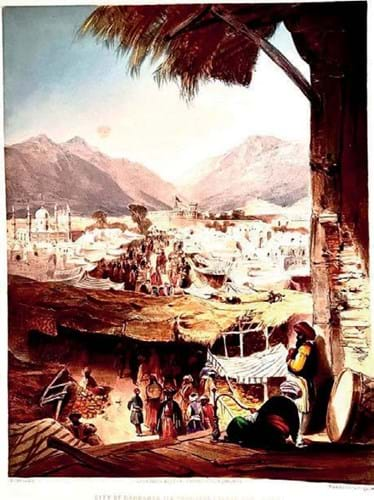
One of three lithographs of Afghan subjects, part of a portfolio of prints after original drawings by James Rattray that made £8600 at Cato Crane.
With some pages loose and lithographs suffering from foxing throughout, the portfolio was offered as a single lot with an estimate of £200-300. But with the rarity of these prints, together with an increase in interest in Afghan history in recent times, they drew prolonged bidding and were knocked down at £8600 to a US internet buyer.
While another copy of the same edition made £9800 at Dominic Winter in 2015, the highest auction price for one of the few individual works by Rattray that have emerged at auction is a watercolour of General Paolo Avitabile’s house in Peshawur (then an Afghan city but now in Pakistan) that made £9500 at Christie’s in 2020.
Palace picture
Meanwhile, a fortnight later at another south London saleroom, Roseberys (25% buyer’s premium), strong competition came for a historical picture of the Indian subcontinent by a British artist.
The 7¾ x 10½in (20 x 27cm) watercolour was indistinctly inscribed Chutterpore Palace / JL Stewart to the lower right.
The artist, James Lawson Stewart (1841-1929), is mainly known for depicting views of London although he also painted views of the north of England. Most of his works sell for sums in the hundreds of pounds with a record £2200 bid for a pair of views near London Bridge at Sotheby’s back in 1999.
The main attraction here was the subject. More commonly known as the Rajgarh Palace (or the Khajuraho Fort Palace), the magnificent building depicted stands on the slopes of the Managad hills in central India. It was built by Maharaja Hinu Pat Shah of the Bundela dynasty and, although it has now been converted into a heritage hotel, it remains a significant tourist attraction.
The work had been bought at an auction in Geneva only last September for SwFr300 (£270) – a price that proved to be a bargain judging by the demand at Roseberys.
Offered from a UK private vendor at the March 29 sale and pitched at £300-400, it was eventually taken up to £4600, selling to an internet buyer and setting a new high for the artist at auction.
Industrial might
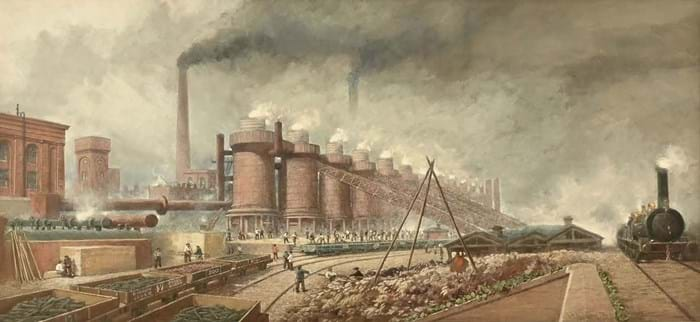
One of two watercolours by George Henry Andrews depicting Barrow’s iron and steelworks that made £3200 and £4100 at Mitchells.
Depicting scenes a little closer to home, two industrial landscapes by George Henry Andrews (1816-98) were the subject of interest at Mitchells (25% buyer’s premium) of Cockermouth March 22.
An engineer and marine artist, his most famous works are probably the views of the archaeological excavations in Egypt that he produced for Howard-Vyse’s three-volume Operations Carried on at the Pyramids of Gizeh (1840-42). As with those pictures, his knowledge of engineering was evident in the current works.
The pair of 19¼in x 3ft 6in (49cm x 1.07m) watercolours showed the enormous blast furnaces, steel sheds, rolling mills and stocks of rails of the Barrow Haematite Steel Company.
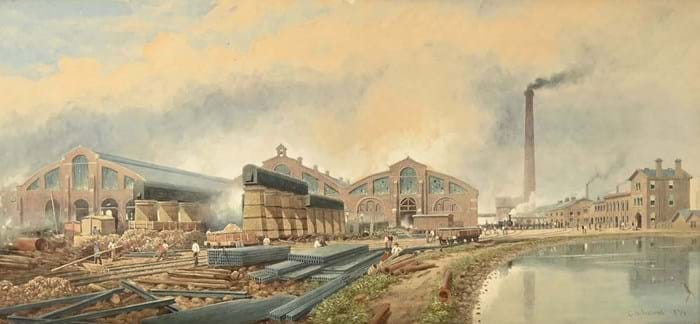
One of two watercolours by George Henry Andrews depicting Barrow’s iron and steelworks that made £3200 and £4100 at Mitchells.
They dated from 1874 and conveyed the might of Victorian industry in the north-west. At the time the steelworks were in constant use, supporting the booming railway industry although, remarkably, there is now no physical trace remaining of Barrow’s iron and steelworks.
Both works were pitched at £500-800 but, effectively being an important part of the visual record of the area’s history and Britain’s industrial revolution more widely, the first work was taken to £3200 and the second made £4100.


